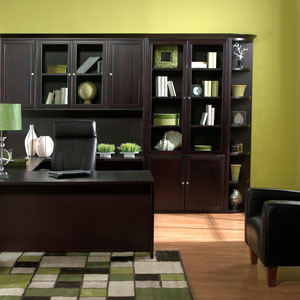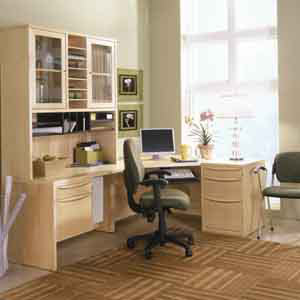Your home office is more than just a desk and a chair. Design for maximum productivity. Photo: Jesper Office
Home Office Shopping Tips
Here are a few things to have handy when shopping for home office furniture:
- Dimensions of the room or space you plan to use as your home office
- Location and sizes of windows and doors
- Your color scheme
- The types of lamps and lighting you have and will need to illuminate your workspace
Plan For Success
Before you hit the stores, consider planning a bit on paper. Jesper Office offers space-planning software for room design and furniture selections with an option of viewing the design in 3-D, says Joern Skarregaard, president/CEO of Jesper Office. You can download it from their website (jesperoffice.com) or view it in retail stores selling Jesper Office products.
“Our experience is that if the consumer has prepared their own design proposal and consulted with the sales staff in the stores, the outcome is much better,” says Skarregaard.
-
Smart Home Office Solutions
What to look for when buying home office furniture.
- by Jason Schneider
If you’ve decided to create a home office, whether you work from home or just want a quiet place to use the computer, one of the first things you’ll need is office furniture. But what do you look for, and what do you need to know to make the right decisions? Here are some questions to simplify your home office shopping experience.
Where will it be?
First, know where you plan to have your home office. Will it be a corner of the master bedroom or living room, or a room of its own?
“The dedicated home office will typically have more storage, whereas the home office as part of the living room is designed to be integrated into the room,” says Joern Skarregaard, president/CEO of home office furniture manufacturer Jesper Office.
If you’re planning on working at home, choose furniture that:
- Is functional
- Provides sufficient work space
- Is of good quality and durability
For simple recreational use, a computer desk or computer armoire that provides space for your computer, printer and supplies may be sufficient.
“Functionality is very important,” Skarregaard says. “If a consumer invests in a home office, they should expect all necessary functions to be covered.”
What should you look for?
“When consumers buy a sofa, they expect a wide selection in sizes, designs, colors, etc.,” says Skarregaard. “They should not expect less when buying home office furniture.”
A typical home office, he says, is a desk with a return, one three-drawer mobile pedestal with filing, and a bookcase.
Some home office components to consider:
- Desks: From simple writing desks to larger, expandable units, choose one that provides the workspace you need.
- Hutches: Allow you to expand the area above your desk with shelves and storage.
- Bookcases: Great for displays and additional storage.
- Filing cabinets: For paperwork and important documents.
- Chairs: Look for adjustable height, lumbar support, armrests, breathable fabric and adequate padding.
How much storage do I need?
With the majority of today’s paperwork and files being electronic, you might think there is less need for storage in a home office. But Skarregaard says that’s not the case.
“Despite the so-called ‘paperless office,’ we do not experience less demand for storage than five years ago,” he says, adding that mobile pedestals are the best-selling storage units. Lateral file cabinets and credenzas are also popular.
Depending on how much you have to store, look for:
- Lateral Filing Cabinets: With sideways orientation, these save space and can hold a lot of files.
- Vertical Filing Cabinets: A more traditional way of filing, these are taller and narrower than lateral files, and may hold less.
- Bookcases and Hutches: Versatile and able to hold books, paperwork or other supplies in baskets or trays. Also good for displaying photos, awards and personal items.
- Credenzas: Provide secondary workspace and additional storage.
Your home office is more than just a desk and a chair. Design for maximum productivity by analyzing your needs, your space and your work style.
A final tip from Skarregaard: begin with the future in mind. When it comes to home offices, “the needs and possibilities are changing over time and make expandability and versatility important,” he says.



